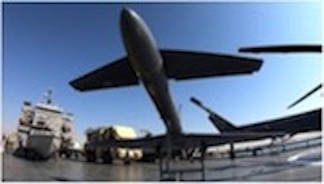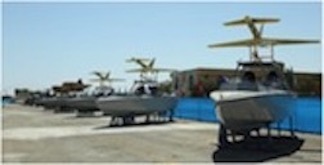Islamic Revolutionary Guard Corps Note No. 1: IRGC-Navy Unveils Naval Carrier, Shahid Roudaki and New Drones, Helicopters, and Speed Boats
Alma Keshavarz and Robert J. Bunker
Shahid Roudaki
The IRGC-Navy held a ceremony in Bandar Abbas on the Strait of Hormuz on 19 November 2020 to unveil its new naval carrier, Shahid Roudaki. According to the accompanying Iranian news outlet Mashregh News,the ceremony was held with IRGC Commander Major General Hossein Salami and other military and national officials in attendance. The carrier is described as a heavy combat, intelligence, and support ship intended to provide security for maritime transport lines as well as supporting commercial and fishing fleets. According to the report, the carrier weighs 40,000 tons and is 150 meters long and 22 meters wide. It carries surface-to-surface missiles, surface-to-air missiles, helicopters, and unmanned aerial vehicles (UAV), among other missiles and aircraft.

Aerial view of Shahid Roudaki. Source: Fars News, 19 November 2020, https://www.farsnews.ir/news/13990702000194/الحاق-۱۸۸-فروند-پهپاد-و-بالگرد-به-نیروی-دریایی-سپاه-رونمایی-از-۳.

Ababil-2 aboard Shahid Roudakie during unveiling ceremony. Source: Fars News, 19 November 2020, https://www.farsnews.ir/news/13990830000500/صیانت-از-منافع-ملی-در-آب%E2%80%8Cهای-دوردست-با-ابتکار-عمل-ندسا-ناو.
Per another accompanying state outlet Fars News, IRGC-N Commander Alireza Tangsiri said that the vessel would also be used in distant waters, including as far away as the Indian Ocean. The vessel is further described as able to carry out aerial operations using cruise missiles and can defend itself using Iran’s indigenously made 3rd Khordad defense system. It is also equipped with four dual launchers of cruise missiles that, if used with the Ghadir medium-range anti-ship cruise missiles, can fire at targets with a range of up to 300 kilometers. The vessel carries six Ababil-2 UAVs, which have a range of 100 kilometers, 75-120 minutes of flight time, an altitude of 11,000 feet and a max speed of 250 kilometers per hour. The Ababil-2 does not need a runway for landing and takeoff, which is ideal for a vessel of this kind with its deck configuration. The report notes that the vessel is the beginning to provide more effective deterrence capabilities.
Key Translated Quotes:
IRGC-N Commander Alireza Tangsiri said that this vessel would also be used in distant waters, including as far as the Indian Ocean.
Shahid Roudaki is a heavy combat, intelligence and support ship that also offers security to maritime transport lines, and also provides relief to commercial and fishing fleets.
Source: “Alhagh nav aghanosh pema Shahid Roudaki be neeroye darya-ee Sepah (Shahid Roudaki is the latest addition to the IRGC Navy).” Mashregh News. 19 November 2020,
Shahid Roudaki can carry out aerial operations using cruise missiles and defend itself using the 3rd Khordad defense system.
Source: “Sehat az manafe melee dar ab-haye doordast ba Ebtekar aml nedesa/nav agheya nospema sepah che veejghhay-ee dard? (What defines protecting national interests in distant waters/a new IRGC vessel?).” Fars News.19 November 2020, https://www.mashreghnews.ir/news/1121994/ابابیل-سپاه-این-بار-در-دریا-به-دنبال-یاران-ابرهه-می-رود-ترکیب.
While not stated in the Iranian news reports, the Shahid Roudaki, in actuality, is a repurposed merchant vessel. It is meant to serve as a special operations ship with limited power projection capabilities. Its ‘carrier’ designation is a misnomer and is being utilized for IRGC propaganda and narrative purposes. Such perceptions are consistent with the unveiling of a number of IRGC military systems two months prior which portray ongoing Iranian propaganda activities.
New Drones, Helicopters, and Speed Boats
On 23 September 2020, the Islamic Revolutionary Guard Corps (IRGC) Navy unveiled 188 new systems, including unmanned aerial vehicles (UAVs), helicopters, and speed boats. In an unveiling ceremony in Bandar Abbas, Iran, IRGC Commander Hossein Salami and IRCC-N Commander Alireza Tangsiri gave their remarks on the indigenously made military advancements. According to the accompanying Iranian state news agencies Fars News and Tasnim News, the UAVs have been developed exclusively by Iran’s Aviation Industry Organization. Tangsiri noted that three of the new UAVs are being viewed for the first time, and they can be launched from a submarine to carry out specific missions. The reports further that these UAVs include the Sepehr, Shahab 2, and Hudhud 4 models, as well as the commonly used Ababil series.

IRGC-N speedboat affixed with Ababil-2 UAV. Source: Mashregh News. 23 September 2020, https://www.mashreghnews.ir/news/1121994/ابابیل-سپاه-این-بار-در-دریا-به-دنبال-یاران-ابرهه-می-رود-ترکیب.
According to Iranian state news Mashregh, the newest initiative by the IRGC-N is the installation of an Ababil-2 UAV on a newly designed high-speed vessel. According to the report, UAVs and speedboats have not only been the two preferred weapons and vessels of choice but, most importantly, both have been pillars of the IRGC-N military doctrine. Salami and Tangsiri explain that this development has propelled the IRGC-N into a new field of imposed warfare, as their doctrine is both an effective power as well as a deterrent. The report explains that the speed boats have an increased speed capability; they can be armed with cruise and torpedo missiles; and the IRGC-N is currently developing unmanned missile launchers and designing means to reduce the radar cross-section of the vessels.
Key Translated Quotes:
This new development has propelled the IRGC-N into a new field of imposed warfare.
IRGC-N Commander Alireza Tangsiri explained that these drones include the Sepehr, Shahab 2 and Hudhud 4. The Mohajer-6 has the highest accuracy at sea and is one of the other drones that joined the IRGC-N.
The newest initiative by the IRGC-N is the installation of an Ababil-2 drone on high-speed vessels. This is a new combination and capability for the elite Navy.
Source: “Alhagh 188 farvand pahpad va balgard be neeroye darya-ee sepah/roonameye az 3 pahpad jadeed (Addition of 188 UAVs and helicopters to the IRGC Navy/Unveiling of 3 new UAVs).” Fars News. 23 September 2020, https://www.farsnews.ir/news/13990702000194/الحاق-۱۸۸-فروند-پهپاد-و-بالگرد-به-نیروی-دریایی-سپاه-رونمایی-از-۳ .
The ceremony in Bandar Abbas was filmed and photographed for the record. These new UAVs can destroy fixed and moving naval targets and are also used for marine surveillance.
Source: “(Ababil) Sepah een bar dar darya be donbal yaran abreh meerood/tarkeeb do keboos Amrika baraye takmeel hemalat fuji nedsa + ax ([Ababil] IRGC looking for helpers at sea/combining two American nightmares to complete attacks + photo).” Mashregh News. 23 September 2020, https://www.mashreghnews.ir/news/1121994/ابابیل-سپاه-این-بار-در-دریا-به-دنبال-یاران-ابرهه-می-رود-ترکیب.
The most noteworthy piece in the report is the unveiling of an Ababil-2 UAV mounted on a newly designed high-speed vessel. The report indicates that, since this can be reproduced at a low cost, these models can be a part of the IRGC-Ns broader AA/A2 strategy. The mounted Ababil-2 will be used for reconnaissance, with missile capability that can engage fixed and moving vessels in the Persian Gulf. Platform stability and launch integrity questions related to the actual Ababil-2 mount, however, suggest that vessel performance will be severely compromised likely negating the high-speed surface harassment and attack advantages being sought.
Analysis
While these new developments by the IRGC-N are more of a propaganda effort than sophisticated military accomplishments, they are still notable. Despite heavy economic sanctions, Iran continues to expand its domestic weapons production and naval capabilities. These developments showcase not a new ‘carrier’ as such, but the fielding of advanced small speed boats and UAS. They only enhance Iran’s broader military doctrine, which largely depends on signaling to the international community that their most elite military branch can increasingly pose a threat to global chokepoints in their slowly expanding areas of operation.
About the Author(s)
Comments
Useful overview of IRGCN…
IRGCN converted vessel Shahid Roudaki (L110-1) may appear to be Iranian interpretation of USN expeditionary mobile base ship class. (USS Lewis B. Puller has been deployed to U.S. 5th Fleet's area of operations in 2017.)
There also appears to be a larger, similarly purposed IRIN converted vessel under development, the IRINS Makran.

